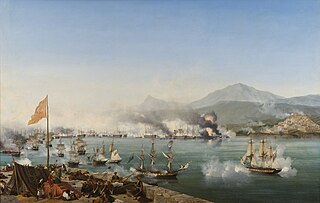
The Battle of Navarino was a naval battle fought on 20 October 1827, during the Greek War of Independence (1821–29), in Navarino Bay, on the west coast of the Peloponnese peninsula, in the Ionian Sea. Allied forces from Britain, France, and Russia decisively defeated Ottoman and Egyptian forces which were trying to suppress the Greeks, thereby making Greek independence much more likely. An Ottoman armada which, in addition to Imperial warships, included squadrons from the eyalets of Egypt and Algiers, was destroyed by an Allied force of British, French and Russian warships. It was the last major naval battle in history to be fought entirely with sailing ships, although most ships fought at anchor. The Allies' victory was achieved through superior firepower and gunnery.
Sixteen ships and two shore establishments of the Royal Navy have been named HMS Fox, after the fox.

The Battle of Fehmarn (1644) took place north-west of the island of Fehmarn, now part of Germany, in the Baltic Sea. A combined Swedish fleet, with a large element of hired Dutch ships, defeated a Danish-Norwegian fleet and took 1,000 prisoners, including Ulfeldt, Grabov and von Jasmund. The Danish admiral Pros Mund was killed in the battle.

This was a series of mainly small-ship actions which occurred along the coast of what is now Ukraine during the Russo-Turkish War (1787–1792) as Russian and Turkish ships and boats supported their land armies in the struggle for control of Ochakov, a strategic position. The main actions at sea happened on 17, 18, 28 and 29 June and 9 July 1788. On 9 July also, the larger Turkish ships left and on 14 July they fought the Russian Sevastopol Squadron about 100 miles to the south.

The Battle of Palermo took place on 2 June 1676 during the Franco-Dutch War, between a French force sent to support a revolt in the city of Messina against the Spanish rule in Sicily, and a Spanish force supported by a Dutch maritime expedition force.

HMS Cambrian was a Royal Navy 40-gun fifth-rate frigate. She was built and launched at Bursledon in 1797 and served in the English Channel, off North America, and in the Mediterranean. She was briefly flagship of both Admiral Mark Milbanke and Vice-Admiral Sir Andrew Mitchell during her career, and was present at the Battle of Navarino. Cambrian was wrecked off the coast of Grabusa in 1828.

HMS Aigle was a 36-gun, fifth-rate frigate of the Royal Navy. Ordered on 15 September 1799 and built at Bucklers Hard shipyard, she was launched 23 September 1801. More than fifty of her crew were involved in the Easton Massacre when she visited Portland in April 1803 to press recruits. Her captain and three other officers stood trial for murder but were acquitted. Much of Aigle's career as a frigate was spent trying to keep the English Channel free of enemy warships and merchant vessels. On 22 March 1808, she was first into the action against two large French frigates, compelling one to seek the shelter of the Île de Groix batteries and forcing the other onto the shore.





